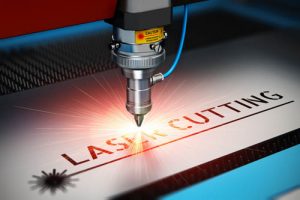Laser cutting is a technology that utilizes laser beams to cut through materials. Laser cutting can be found in industrial manufacturing applications. In recent years, the technology has become more affordable and is being used by hobbyists, in small business operations and in schools.
The way laser cutting works is that it directs the output of a high-powered laser beam, most commonly through optics devices. The laser optic and computer numerical control technology work together to direct the material, or the laser-beam generated light.
In commercial settings lasers can cut materials that move in a straight line or those that are curved. The motion of the laser beam is controlled to follow a CNC (computer numerical control) or a G code pattern for the material. Once the cut design has been determined, a focused laser beam will be directed at the material. The laser will either burn, melt or vaporize, or be blown away with a jet of gas to leave an edge that has a high-quality surface finish.
In an industrial setting, the laser cutters can cut flat-sheets of materials, piping materials or other structural materials.
Laser cutting is a go-to process for small quantity jobs because it’s fast, accurate, and the edges are generally smooth and don’t require additional smoothing processes. A laser cutter cannot perform every task though. There are limits to the thickness of the materials that can be easily cut using a laser. Additionally, lasers can generate too much heat and that could affect the material being cut – especially plastics and rubber material.
When laser cutting is not an option, water jet cutting can be substituted. Water jet cutting is a slower process, offers comparable accuracy and smooth edges. Unlike laser cutting, though water jets don’t generate any heat that could negatively impact the material.
Water jet technology is better for:
- Nonmetallic materials
- Reflective metals
- Materials ranging up to 12 inches in thickness
- Applications in which heat could be a concern
Laser technology is best for:
- Ferrous metals
- Uses when speed is essential
- Thin materials
- Applications where heat is not a concern
Universe Kogaku designs and manufactures optical lenses for industrial, medical, high tech and electronic applications. Standard and custom lens assemblies for scanners, CCTV, CCD/CMOS, medical imaging, surveillance systems, machine vision and night vision systems are also available.